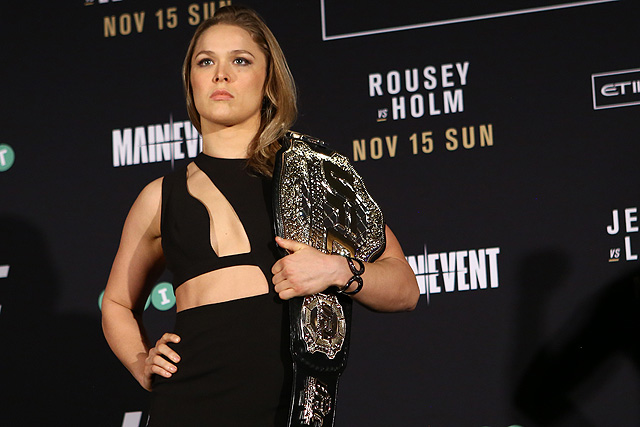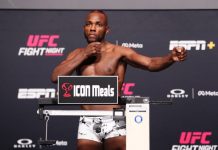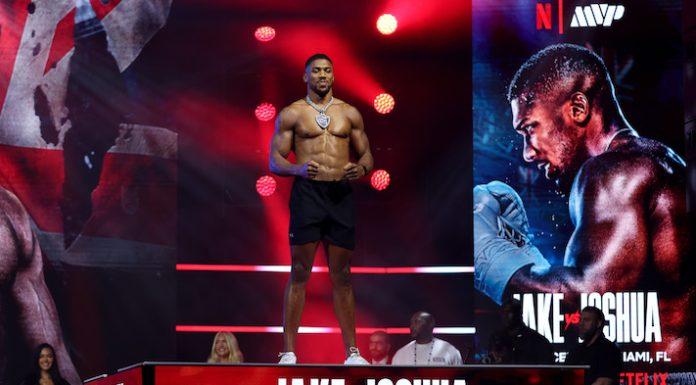
Ronda Rousey has signed with the WWE, and leaves behind one of the most influential careers in the history of mixed martial arts.
Former UFC women’s bantamweight champion Ronda Rousey blew up the Twitterverse by making her debut at WWE’s Royal Rumble late Sunday night. While details of her move to pro wrestling have been circulating for months, she took the opportunity to make surprise fans by appearing at the event. As Rousey turns the page on professional endeavors, she leaves behind one of the most influential careers in the history of mixed martial arts.
Rousey made her professional MMA debut in 2011, just three years after taking home a Bronze medal in Judo at the Beijing Olympics. Just short of a year later, she had not only made her Strikeforce debut but also had her career turning championship bout with Miesha Tate. The fight sold itself like few bouts ever have: two beautiful women who were not only skilled martial artists but also harbored a genuine dislike for each other. It was the fight that UFC President Dana White claimed changed his mind about having women fight in the UFC.
In 2013, Rousey became the first woman to ever compete in the UFC when she defended the inaugural women’s bantamweight title against Liz Carmouche. She would then go on an electrifying run of success six consecutive title defenses, a UFC record that still stands for the women’s divisions. She was the perfect athlete to be the face of a new kind of mixed martial artist. A complete contrast to the Royce Gracies and Chuck Liddells of the world; Rousey had movie star looks, dominant skills in the cage, and an unapologetic confidence on the microphone that set her apart from her peers.
With every victory, her reputation grew exponentially. She recorded a record-setting 16-second knockout in a championship match that stunned the MMA world, only to outdo herself with a 14-second victory in her following outing. Her rise coincided with changes in social media. Her record-setting performances were so quick that it became internet fodder; her fights ended so quickly that you could watch the whole match them within Instagram’s 15-second limit. Right before our eyes, Rousey became a household name. Stories of her mother putting her in arm-bars around the house growing up were becoming as familiar as the story of Michael Jordan being cut from his high school basketball team.
Say hello to 2016 #SISwim cover model @rondarousey! The best part, she’s one of three https://t.co/JvM8UqzlIL pic.twitter.com/30GmY6em1P
— Sports Illustrated Swimsuit (@SI_Swimsuit) February 14, 2016
The UFC had a bonafide superstar, and they took full advantage of it. Rousey would become the first MMA fighter to be a frequent guest on the late night talk show circuit. She would grace the covers of Maxim, the Sports Illustrated Swimsuit Issue, Men’s Fitness, Ring Magazine, and the ESPN Body Issue. Rolling Stone wrote a feature proclaiming her “The Most Dangerous Woman Alive.” Movie appearances soon followed, with Rousey appearing in Fast 7, The Expendables 3, and The Entourage Movie.
And then it was over.
In 2015, the Rousey train appeared so unstoppable that a victory over Holly Holm was a foregone conclusion. In what would go down as one of the biggest upsets in sports history “The Preacher’s Daughter” annihilated Rousey in front of the world. For seven jaw-dropping minutes, virtually every strike Holm through connected on Rousey, leaving the champion unceremoniously tumbling into the cage and staggering on her feet. When the infamous head-kick was delivered, it was the final swing of the hammer to crush all Rousey had built.
Ronda Rousey would appear scarcely in the months following, but most notably did not speak to the media. Her only interviews would be on the guest friendly talk-show couches of Ellen Degeneres and Conan O’Brien on television where she was never pressed uncomfortably to discuss the aftermath.
Her final fight against Amanda Nunes in 2016 was a unique case. The UFC obliged her request to not do media, making only necessary appearances in promo materials for the bout. The most optimistic hope was that Rousey would come in reinvigorated, ready to work behind a jab to clinch Nunes and force the fight to the mat. Instead, the four-minute demolition that ensued was not as much shocking as it was a cold realization: the game had passed Rousey by.
In the months since, as ESPN’s Brett Okamoto so eloquently described, she seems to almost harbor resentment toward the sport of MMA. She has spoken out to say that fans and media alike turned on her following the loss of her title and describes it as the reason she has not been as open with the public in recent years.
Everyone's eyes are on #WrestleMania 34…
…including @RondaRousey's!!! #RoyalRumble pic.twitter.com/ynkps4gqx5
— WWE (@WWE) January 29, 2018
On Sunday, it was a familiar sight in an unfamiliar setting. There was “Rowdy” Ronda Rousey, walking out to Joan Jett’s “Bad Reputation,” and wearing the trademark scowl on her face. The scene was different: Asuka Nakamura, Charlotte Flair, and Alexa Bliss will face off with Rousey but the winner has already been decided. And perhaps, that’s exactly what she wants.
Interviews with ESPN’s Ramona Shelbourne show Rousey overcome with joy to embark on her latest endeavor. Rousey herself claims that she hasn’t retired from MMA. She also reminds people that she never retired from Judo either. But, just as there is no doubt that she will ever step onto a Judo mat again, confidence is not high on a return to the cage either.
Ronda Rousey was as close to a shooting star as there may ever be in mixed martial arts: burning so brightly in the night that it captures everyone’s attention, so breathtaking in those moments that people project their goals and dreams along with it. And just like that, vanished, leaving a great memory as it continues down its path.




















